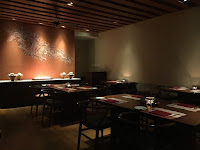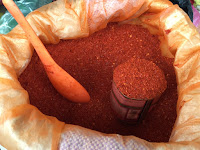After doing some sightseeing in Thimphu we made our way to Punakha about 80 kms away. It took us about 3 hours to get there as the only road goes around the mountain ranges and is in poor condition. There are road-works in effect as they are trying to widen and improve the road, but it is a big project and is far from complete. That said, the long and very bumpy journey was worth it, as Punakha is beautiful.
Punakha served as the capital of Bhutan for over 300 years before the capital was moved to Thimphu in the mid-1950's. Punakha is the winter seat of the Chief Abbot and the monk body.
Punakha is at an altitude of 1300 metres and is considered part of Western Bhutan. It is located in the fertile and beautiful valley at the junction of the Mo Chhu (Mother River) and Pho Chhu (Father River). The low altitude of the Punakha valley and the temperate climate allows for rice crops to grow twice a year, and oranges and bananas to grow in abundance.
Druk Wangyal Chortens at Dochula
On the way from Thimpu to Punakha we stopped at the 3000 metre high mountain pass of Dochula. We stopped here and got some panoramic views of the Himalayas This area is also home to the Druk Wangyal Chortens - 108 stupa built by the eldest Queen Mother, Her Majesty Ashi Dorji Wangmo Wangchuk.
Uma Punakha by COMO
Our two night's accommodation in Punakha was at Uma Punakha by COMO, the sister hotel to Uma Paro by COMO. Our whole trip was planned through the COMO Group and it was great that we didn't have to worry about anything.
Uma Punakha sits on a hill and overlooks the valley with rice fields and the river. It has the feeling of a lodge and like all the other COMO properties is breathtaking and special it its own way. Our room had amazing views of the river and the surrounding mountains and rice paddies. Like our experience at Uma Paro, we got to enjoy great hospitality, great food and the gorgeous surroundings.
Khuruthang Weekend Market
We spent part of the one morning at this weekend vegetable market. This bustling market brings together farmers and their produce from the local area and some imported items from India.
We are so impressed with Bhutan's sustainable farming practices and the government's approach to conservation whereby it has been mandated that 60% of the land has to remain forested for future generations. In addition, 80% of the produce currently produced is organic and our guide mentioned that the goal is to be 100% organic by 2020. Interestingly enough, one of the questions on our arrival card asked if we were bringing in any GMO's!
Chimi Lhakhang
We visited Chimi Lhakhang, also affectionately known as "The Fertility Temple". This temple was built in 1499 and is dedicated to Drukpa Kuenley, a Tibetan Buddhist saint (he was better known as the "Divine Madman").
Childless women and couples go to this temple to receive a blessing from the saint, and newborns are also brought here to be named. The funny thing is that they all leave with the same name: Chimi/Chimmi!
Like the other temples in Bhutan, this one is surrounded by numerous spinning prayer wheels and two enormous ones. Prayer wheels are a ubiquitous sight in Bhutan. These revolving cylinders are filled with printed prayers that are "activated" each time the wheel is turned in a clockwise direction.
Khamsum Yulley Namgyal
David went on a hike through the terraced farmland and then up to the Khamsum Yulley Namgyal. This temple was built by the third Queen Mother and is a splendid example of Bhutanese architecture. Its details have been drawn from religious scriptures. This temple took 9 years to build and was completed in 1999.
Archery
On our way to do some sightseeing one morning, we passed this group of men dressed in their traditional dress (ghos) taking part in a friendly archery competition. We watched part of this spirited competition and it was very entertaining. Archery is Bhutan's national sport.
Punakha Dzong
The highlight of our trip to Punakha was a visit to the breathtakingly beautiful Punakha Dzong. This Dzong was built in the 17th century by Zhabdrung Ngawang Namgyal, who founded the Kingdom of Bhutan.
Punakha Dzong is situated where the town's two main rivers, the Mo Chhu (Mother River) and the Pho Chhu (Father River) converge and it is the venue for the coronation of kings in Bhutan. In 2008, the fifth and current king underwent a secret ceremony in this Dzong, where he received the royal raven crown before proceeding to a formal coronation in Thimphu. Punakha Dzong is also the winter home of the Chief Abbott (head abbott of Bhutan) and approximately 100 monks.
We picked a perfect time to visit Bhutan, because while we were there the King and Queen of Bhutan had their first baby. The birth of the royal baby was a very joyous event and one of the special things that took place to celebrate the birth was the hanging of a special painting at the Punakha and Thimphy Dzongs. This huge painting was only up for a few days and visitors to the Dzong were allowed to view it.

















































































































No comments:
Post a Comment